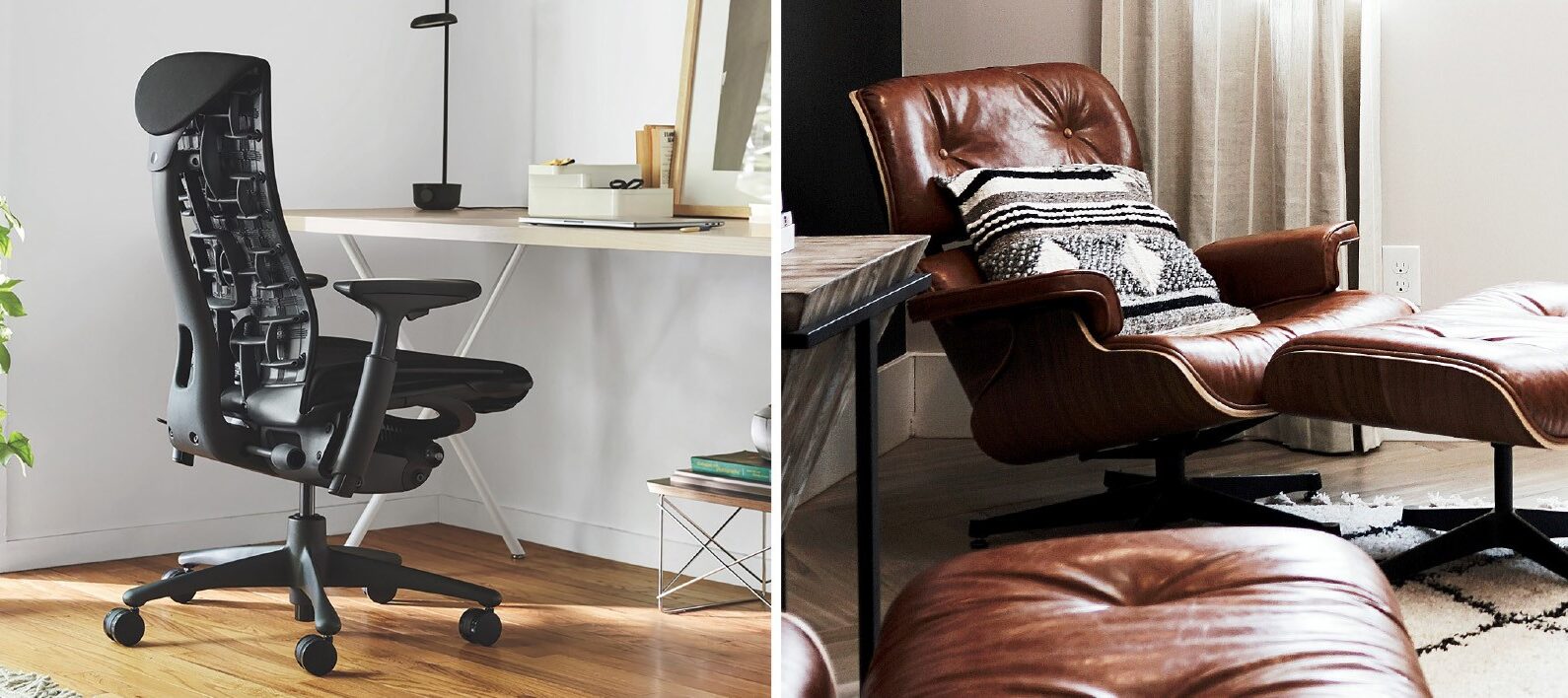
Furniture is one of the hidden stories of our working lives – yet paradoxically it is very much on display. When working from home, that display might be a very visible part of your living room, kitchen, or bedroom. But whether it’s a branded office space or the very personal brand of your home workspace, your office furniture is the cohesion of form and function that commands your comfort, your physical health, and your personal aesthetic for many hours each and every day. That makes it worthy of deep consideration.
The Seat of Comfort
Your office chair is where you take care of business. Why not let your chair take better care of you? Style and design matter, especially for this too-often overlooked item. Consider the craftsmanship of the Eames Lounge Chair. Perhaps the reigning icon of furniture design, it has combined comfort and style since 1956, and is now a part of the Museum of Modern Art’s permanent collection in New York. Designed by Charles and Ray Eames for Herman Miller, the prototype was literally created for comfort – to allow Billy Wilder to take naps on his film sets. Ever since, the molded plywood, aluminum base, and leather upholstery chair has taken centre stage in the world of design. But do we really need museum-quality furniture in our homes?
Alexa Bustamante is an A&D representative for Herman Miller, whose name has long been synonymous with premium office furniture. Her consultative approach helps clients – primarily architects and designers – determine the best design solutions for their spaces. Good design and expert consideration of comfort are inextricable. And both, says Alexa, should be taken very seriously. “I always think it’s interesting when people can justify a premium vehicle purchase that is used for only a couple of hours a day, compared to buying a premium task chair that you sit on for eight or more hours each day,” she says. “The value of a Herman Miller product is directly correlated with the research behind the design,” says Alexa. “As Charles Eames famously said: ‘The details are not in the details. They make the design.’” So what gives this iconic furniture such enduring cachet? “Herman Miller furniture is designed with a human-centered approach, meaning that every detail in the design solves a unique problem that will improve the well-being of the person using it,” she explains. “It is this purposeful, research-based approach to design that makes each Herman Miller product a timeless, durable, and highly customized solution.”
Finding Your Fit
Good design is a whole lot more than looking pretty. What we casually categorize as ergonomics is really a much broader and deeply important health consideration. From muscle tension and headaches to circulation problems, joint pain, lung capacity, strength, and fatigue, the chairs we sit in contribute greatly to our overall health. Two examples from Herman Miller’s classic collection transformed an era of design, combining technological innovation and purposeful, people-led, painstakingly high-quality design. To this day, both products retain their timeless aesthetic and lasting appeal.
The Aeron Chair: First released in 1994, the Aeron chair was dubbed America’s best-selling chair. It, too, has a home in the Museum of Modern Art. “How pressure is distributed across the body makes a significant difference in how comfortable you are while sitting,” says Alexa. “Aeron’s innovative Pellicle seat and back distribute your weight evenly, eliminating pressure points and heat build-up. It took decades of design research to develop a chair that was health-positive.”
The Embody Chair: A team of more than 30 physicians and PhDs in biomechanics, vision, physical therapy, and ergonomics designed the Embody chair to increase blood circulation, improve oxygen flow, and lower your heart rate. Designed to mimic the human body, the chair features a central spine and flexible ribs. “It automatically conforms to your body’s micromovements,” says Alexa, “and is the only chair on the market you can get prescribed by a doctor.”
Over the past few years, Herman Miller has acquired a number of companies to create a wider Herman Miller family of brands. That means more design options that cater to different price ranges, health needs, and aesthetic preferences. As the home office takes a prime seat in the workplace of the future, a higher standard of visual and functional design may become a more important consideration for many.
Past Volumes

Volume 35
Summer 2022
Click below to read

Volume 34
Winter 2021
Click below to read

Volume 33
Summer 2021
Click below to read

Volume 32
Winter 2020
Click below to read